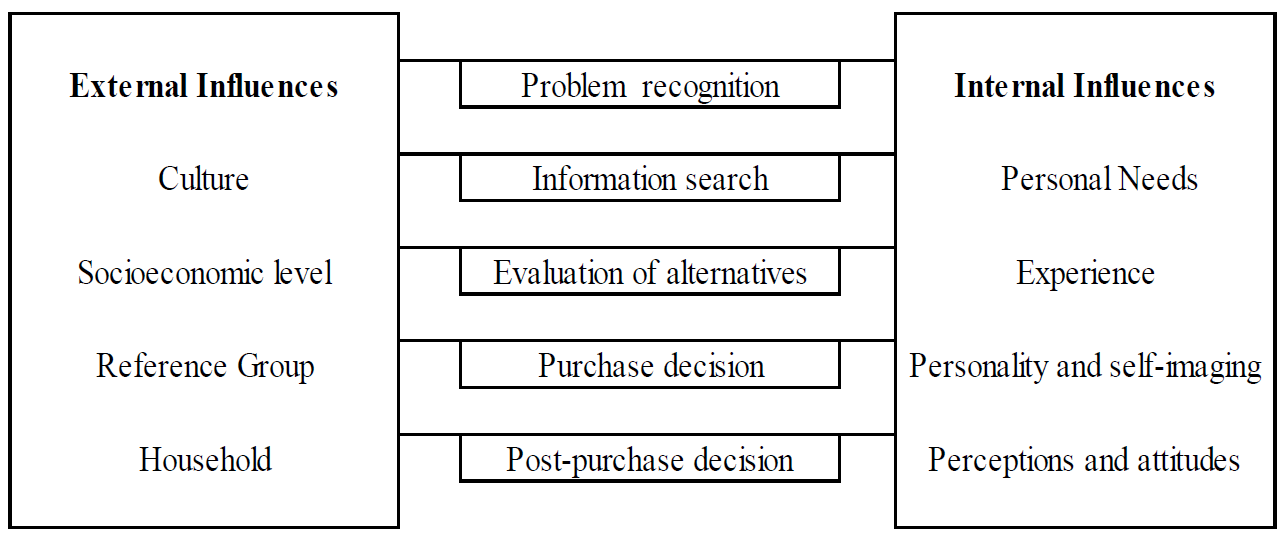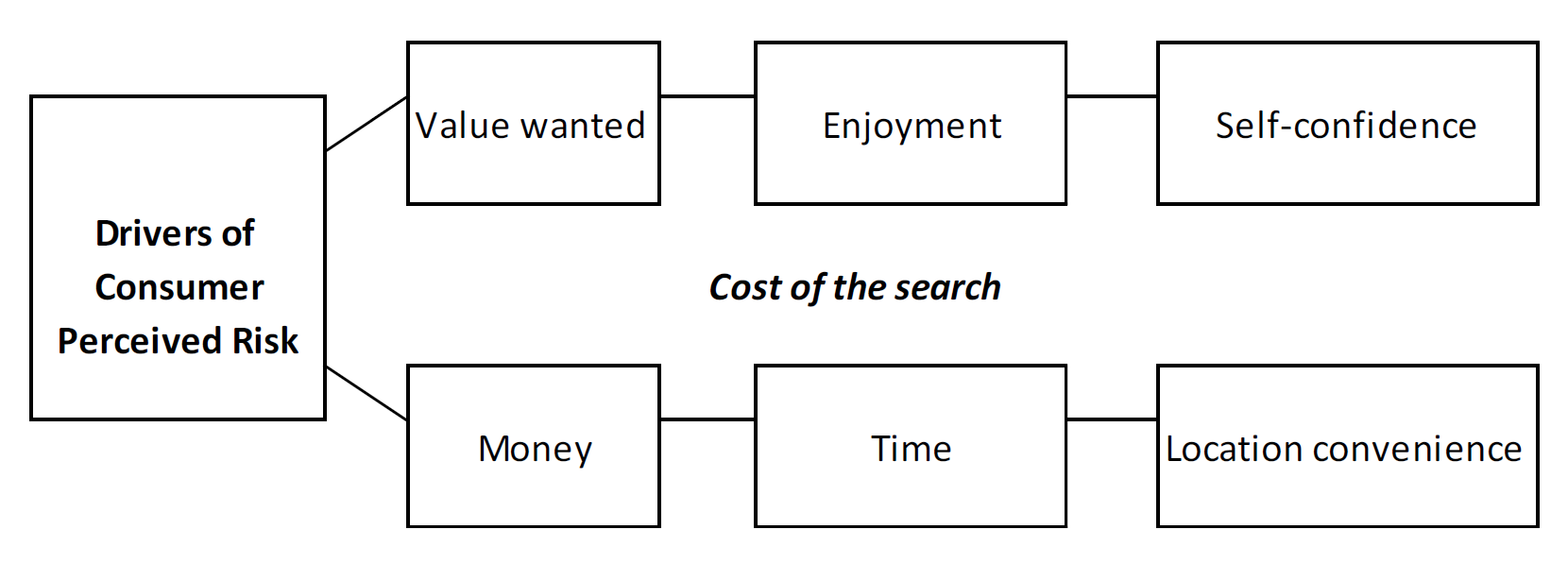2.4: Customer Decision Cycle
- Page ID
- 22073
\( \newcommand{\vecs}[1]{\overset { \scriptstyle \rightharpoonup} {\mathbf{#1}} } \)
\( \newcommand{\vecd}[1]{\overset{-\!-\!\rightharpoonup}{\vphantom{a}\smash {#1}}} \)
\( \newcommand{\id}{\mathrm{id}}\) \( \newcommand{\Span}{\mathrm{span}}\)
( \newcommand{\kernel}{\mathrm{null}\,}\) \( \newcommand{\range}{\mathrm{range}\,}\)
\( \newcommand{\RealPart}{\mathrm{Re}}\) \( \newcommand{\ImaginaryPart}{\mathrm{Im}}\)
\( \newcommand{\Argument}{\mathrm{Arg}}\) \( \newcommand{\norm}[1]{\| #1 \|}\)
\( \newcommand{\inner}[2]{\langle #1, #2 \rangle}\)
\( \newcommand{\Span}{\mathrm{span}}\)
\( \newcommand{\id}{\mathrm{id}}\)
\( \newcommand{\Span}{\mathrm{span}}\)
\( \newcommand{\kernel}{\mathrm{null}\,}\)
\( \newcommand{\range}{\mathrm{range}\,}\)
\( \newcommand{\RealPart}{\mathrm{Re}}\)
\( \newcommand{\ImaginaryPart}{\mathrm{Im}}\)
\( \newcommand{\Argument}{\mathrm{Arg}}\)
\( \newcommand{\norm}[1]{\| #1 \|}\)
\( \newcommand{\inner}[2]{\langle #1, #2 \rangle}\)
\( \newcommand{\Span}{\mathrm{span}}\) \( \newcommand{\AA}{\unicode[.8,0]{x212B}}\)
\( \newcommand{\vectorA}[1]{\vec{#1}} % arrow\)
\( \newcommand{\vectorAt}[1]{\vec{\text{#1}}} % arrow\)
\( \newcommand{\vectorB}[1]{\overset { \scriptstyle \rightharpoonup} {\mathbf{#1}} } \)
\( \newcommand{\vectorC}[1]{\textbf{#1}} \)
\( \newcommand{\vectorD}[1]{\overrightarrow{#1}} \)
\( \newcommand{\vectorDt}[1]{\overrightarrow{\text{#1}}} \)
\( \newcommand{\vectE}[1]{\overset{-\!-\!\rightharpoonup}{\vphantom{a}\smash{\mathbf {#1}}}} \)
\( \newcommand{\vecs}[1]{\overset { \scriptstyle \rightharpoonup} {\mathbf{#1}} } \)
\( \newcommand{\vecd}[1]{\overset{-\!-\!\rightharpoonup}{\vphantom{a}\smash {#1}}} \)
\(\newcommand{\avec}{\mathbf a}\) \(\newcommand{\bvec}{\mathbf b}\) \(\newcommand{\cvec}{\mathbf c}\) \(\newcommand{\dvec}{\mathbf d}\) \(\newcommand{\dtil}{\widetilde{\mathbf d}}\) \(\newcommand{\evec}{\mathbf e}\) \(\newcommand{\fvec}{\mathbf f}\) \(\newcommand{\nvec}{\mathbf n}\) \(\newcommand{\pvec}{\mathbf p}\) \(\newcommand{\qvec}{\mathbf q}\) \(\newcommand{\svec}{\mathbf s}\) \(\newcommand{\tvec}{\mathbf t}\) \(\newcommand{\uvec}{\mathbf u}\) \(\newcommand{\vvec}{\mathbf v}\) \(\newcommand{\wvec}{\mathbf w}\) \(\newcommand{\xvec}{\mathbf x}\) \(\newcommand{\yvec}{\mathbf y}\) \(\newcommand{\zvec}{\mathbf z}\) \(\newcommand{\rvec}{\mathbf r}\) \(\newcommand{\mvec}{\mathbf m}\) \(\newcommand{\zerovec}{\mathbf 0}\) \(\newcommand{\onevec}{\mathbf 1}\) \(\newcommand{\real}{\mathbb R}\) \(\newcommand{\twovec}[2]{\left[\begin{array}{r}#1 \\ #2 \end{array}\right]}\) \(\newcommand{\ctwovec}[2]{\left[\begin{array}{c}#1 \\ #2 \end{array}\right]}\) \(\newcommand{\threevec}[3]{\left[\begin{array}{r}#1 \\ #2 \\ #3 \end{array}\right]}\) \(\newcommand{\cthreevec}[3]{\left[\begin{array}{c}#1 \\ #2 \\ #3 \end{array}\right]}\) \(\newcommand{\fourvec}[4]{\left[\begin{array}{r}#1 \\ #2 \\ #3 \\ #4 \end{array}\right]}\) \(\newcommand{\cfourvec}[4]{\left[\begin{array}{c}#1 \\ #2 \\ #3 \\ #4 \end{array}\right]}\) \(\newcommand{\fivevec}[5]{\left[\begin{array}{r}#1 \\ #2 \\ #3 \\ #4 \\ #5 \\ \end{array}\right]}\) \(\newcommand{\cfivevec}[5]{\left[\begin{array}{c}#1 \\ #2 \\ #3 \\ #4 \\ #5 \\ \end{array}\right]}\) \(\newcommand{\mattwo}[4]{\left[\begin{array}{rr}#1 \amp #2 \\ #3 \amp #4 \\ \end{array}\right]}\) \(\newcommand{\laspan}[1]{\text{Span}\{#1\}}\) \(\newcommand{\bcal}{\cal B}\) \(\newcommand{\ccal}{\cal C}\) \(\newcommand{\scal}{\cal S}\) \(\newcommand{\wcal}{\cal W}\) \(\newcommand{\ecal}{\cal E}\) \(\newcommand{\coords}[2]{\left\{#1\right\}_{#2}}\) \(\newcommand{\gray}[1]{\color{gray}{#1}}\) \(\newcommand{\lgray}[1]{\color{lightgray}{#1}}\) \(\newcommand{\rank}{\operatorname{rank}}\) \(\newcommand{\row}{\text{Row}}\) \(\newcommand{\col}{\text{Col}}\) \(\renewcommand{\row}{\text{Row}}\) \(\newcommand{\nul}{\text{Nul}}\) \(\newcommand{\var}{\text{Var}}\) \(\newcommand{\corr}{\text{corr}}\) \(\newcommand{\len}[1]{\left|#1\right|}\) \(\newcommand{\bbar}{\overline{\bvec}}\) \(\newcommand{\bhat}{\widehat{\bvec}}\) \(\newcommand{\bperp}{\bvec^\perp}\) \(\newcommand{\xhat}{\widehat{\xvec}}\) \(\newcommand{\vhat}{\widehat{\vvec}}\) \(\newcommand{\uhat}{\widehat{\uvec}}\) \(\newcommand{\what}{\widehat{\wvec}}\) \(\newcommand{\Sighat}{\widehat{\Sigma}}\) \(\newcommand{\lt}{<}\) \(\newcommand{\gt}{>}\) \(\newcommand{\amp}{&}\) \(\definecolor{fillinmathshade}{gray}{0.9}\)When foodservice consumers make decisions concerning the purchase of products and services, a decision step process must take place. A broad variety of variables exists based on wants and needs (behavioral aspects) that influence this decision process in the mind of the consumer. Figure 1.3 shows a collective of theories that show both external and internal influences that come into play as consumers make purchase decisions.
This cycle illustrates the major steps progression in the decision-making process, as well as the role external and internal influences play as individuals make purchase decisions. Understanding this cycle is important because both external and internal influences play key roles in the consumer purchase actions, foodservice owners and operators need to develop awareness of the specific influences that are most important to their particular target market segments in a given trading area.
Figure 1.3: Consumer Decision Model

Figure 1.3 indicates five key elements in the decision-making cycle: problem recognition - the foodservice need; the information search to address the need, evaluation of alternatives, the purchase decision, and post-purchase evaluation. The particular trading area and its consumer and market conditions influences each element in the decision-process.
Problem recognition, the need
The decision -making process begins with problem recognition, which occurs when a consumer realizes a difference between his or her actual state, the need for a meal or service, and the desired state, that meal or service that fill the need. Thousands of different stimuli can trigger the awareness of a food need - the problem needing a solution. For example, if one feels hungry when while driving down for an interstate highway, this could trigger the need to search for restaurant signage for ways to address one's hunger. From another perspective, the need to feel important and treated with the utmost respect could lead a different potential customer to search for an upscale hotel with a concierge to help with the decision and reservation process. Additionally, the need may not begin within a single individual. If a couple comes home after both have worked all day, and one decides it would be best to go out rather than make an effort to cook, this creates a joint need that only one of the individuals may have felt. At times, to attract one individual in a family is to garner the other as well. The operation must be able to address a constantly changing broad variety of needs that consumers are attempting to satisfy when they fine the need to dine out (Reid and Bojanic, 2006).
Information search
Once the need for food under any condition reaches a conscious level, the cycle holds that consumers seek to gather or retrieve information (see Figure 1.4). This search can involve a variety of information sources, including reference groups and members of the immediate household, as well as the mass media in form of advertising. Typically, consumers will make comparisons from a number of information sources based on the effort required and the credibility of the source.
If the felt need is as basic as the need to eat because of hunger, the information retrieval process is likely to be brief. That is, the restaurant facility selected in this case is likely a likely choice primarily because of convenience, and the number of sources of information consulted is likely to be quite small. In other situations, the number of sources consulted could be much larger. Consider a convention planner who is coordinating the annual meeting for a professional association.
Figure 1.4: Consumer Involvement Based on Perceived Risk

This individual is likely to consult several sources of information before selecting an appropriate city or hotel for this important event. The important thing for the hospitality
owner or operator to remember is that consumers rely to a certain extent on the mass media for information. The amount of information to research and the length of the consumer decision-making process will increase with the consumer's level of involvement. Consumers tend to be more involved when there is a greater perceived risk of making a wrong choice, which is associated normally with high-priced products or services, situations where visibility is high, or when the event in question involves greater complexity.
As illustrated in Figure 1.4, consumers tend to compare the benefits of search such as value, enjoyment, and self-confidence in the selection with the costs including money, time, or convenience to determine the perceived risk. There are also many other situational factors that will affect the amount of information search, such as knowledge of the product, demographics, in particular income and education, and the market environment.
Evaluation of alternatives
Once the consumer has gathered a sufficient amount of information, the third element in the decision-making process is to evaluate possible
alternatives. When customers are asking themselves at which of several possible restaurant should they dine go through a cognitive process in answering that question, whereby they weigh the positives and negative aspects of each alternative. They also examine the benefits of the product-service mix of each restaurant. Consumers consider the relative importance of each benefit of the product-service mix by making trade-offs between the various benefits and their levels. Ultimately, a group of brands will surface of consideration in the final purchase decision. The decision made centers on the perceived risk associated with each alternative.
Marketing managers in other industries have long recognized this mental process and have used it to their advantage in advertising and promoting their products and services. Rather than simply discussing products and services as if they exist in a vacuum, firms make direct comparisons with the competition. This assists the consumer's cognitive process of evaluating alternatives. Of course, every advertiser makes certain that its product or service compares favorably with those of the competition based on the criteria selected for the comparison.
Making Purchase decision
The fourth stage in the consumer decision-making cycle is the purchase decision. It is at this point that the individual actually makes the decision. All external and internal variables come together to produce a decision and the willingness of the individual to take risks. This risk factor offers a tremendous competitive advantage for hospitality operations. When customers step through the from door of a McDonald's, Burger King, Red Lobster, or any other nationally recognized chain, they are taking a much smaller risk than if they entered an independent restaurant about which they knew very little. Customers typically perceive less risk with the chain operation because the product-service mix is better known to the customer - although superiority certainly not always the case. Independent operations must work hard to establish themselves and reduce some of the risk consumers’ associate with patronizing a restaurant where the restaurant offerings are not well known.
Post-purchase evaluation
This is an additional moment-of-truth when the consumer considers the dining experience and determines if they will return in the future. Following the product-service mix consumption, the final stage is post-purchase evaluation. How did the actual experience compare with the expectations prior to purchase? Was the product-service mix meet the standards anticipated?
Post-consumption feelings focus on two factors: the expectations of the consumer, and the actual performance by the foodservice operation. For this reason, it is very important for any restaurant operation to deliver the products and services promised in advertising promotion or personal selling. Failure to perform at or above the level anticipated by the customer (remember, good is expected as a minimum requirement) is likely to lead to negative post-consumption appraisals. These negative feelings produce dissatisfaction and reduce the level of repeat patronage with no additional referrals a given.
From a management perspective, it is important to promise ‘less’ and deliver ‘more’. Said differently, under-promise and over-deliver. This is a key concept in producing satisfied customers. Finally, remember there is a time-period between the purchase of restaurant operation services, and consumption. During this period, consumers may have second thoughts or negative feelings about the purchase made that refer to 'cognitive dissonance.' Thus, it is important for foodservice operators to run advertisements that depict ‘satisfied’ customers. Always continue to suggest the positive elements of dining in your operation (Blanchard and Bowles, 1993).
Restaurant strengths can compensate weaknesses
Consumers often use a compensatory strategy to allow a product's strengths in one or more areas to compensate for deficiencies in other areas. Said differently, consumers view products and services as bundles of attributes. The final set of alternatives that a consumer is considering for purchase will contain products or services that have various combinations of thee visible attributes and their level of delivery. This evaluation of numerous attributes approach assumes that consumers are capable of evaluating each of a product's benefits and then arriving at an overall assessment, or scores, for products compared to alternative products. Consumers tend to make these complicated comparisons and trade-offs and then choose the product that achieves the highest score.
In sum, restaurant owners and operators should always remember that while many consumers are willing to overlook certain weaker elements of the operation to enjoy a restaurant's strengths, this is not always the case. Some consumers do not allow product strengths in one area to compensate for deficiencies or weaknesses in other areas. Instead, consumers place more emphasis on individual attributes and in some cases develop minimum thresholds to use in evaluating products and services.


